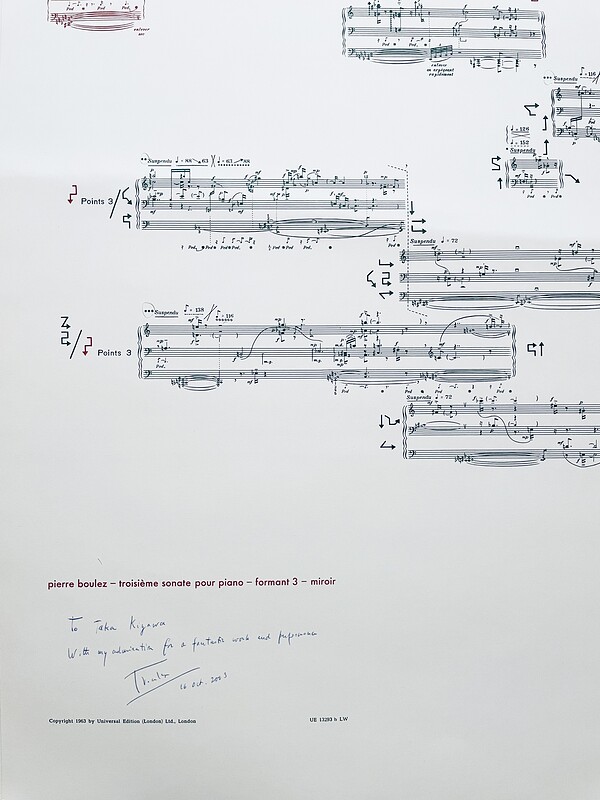Programs
Pierre Boulez: Third Sonata for Piano

"I was very much impressed by the brilliant way he performed them (solo piano works of Pierre Boulez.) He was precise, and at the same time inventive." - Pierre Boulez
"Mr. Kigawa is always a poised guide through the most daunting music, as in his preternaturally unruffled evening-length survey of Pierre Boulez’s complete solo piano works." - Zachary Woolfe, The New York Times
"His warm, intimate accounts of this repertory brought the music down to earth... the pauses in a section of the Sonata No. 3 were consoling, not forbidding..." - Zachary Woolfe, The New York Times
"Playing with suavity and nuance, Taka Kigawa took the stage at Le Poisson Rouge last August with a daunting program: all of Pierre Boulez’s works for piano solo." - Zachary Woolfe, The New York Times
"He conjured a whole world by following a pristine, glassy note with a velvety one in the first movement of the Third Sonata." - Zachary Woolfe, The New York Times
"Kigawa jumped into the last of Boulez’s three piano sonatas, a landmark work in which Boulez asks the performer to choose the order of the movements and their subsections. Intended to consist of five 'formants' or movement, only two exist in full and a third has been published in an incomplete state. Kigawa made an unconventional choice to open with what was conceived as the central movement, 'Constellation-Miroir.' He navigated through a series of seemingly disjointed chords played with surgical precision, before jumping into rarely heard and still unfinished 'Sigle,' a compact work that intones the highest and lowest notes on the keyboard before merging into a filigreed reverie. This progression culminated with the dense 'Trope' that takes its name from a medieval term for plainchant, but seems to owe in larger part to spiky birdsong and experimental jazz." - Amanda Angel, New York Classical Review
"This dynamic pianist has been especially acclaimed for his interpretations of daunting contemporary music. He has long made the solo piano works of Pierre Boulez a specialty in performances that bring out the exhilarating energy and myriad colorings in these fiercely difficult scores. In anticipation of Mr. Boulez’s 90th birthday in March, Mr. Kigawa has been on tour playing the complete Boulez pieces for solo piano in a single recital." - Anthony Tommasini, The New York Times
"Pierre Boulez's Third Piano Sonata is a work of immense visual appeal and curiosity. One movement has staves printed in red and green, straddling huge sheets of cream paper in permutable networks. The other is ring-bound, so that its four sections can be played in different orders. Last Tuesday night at the Greenwich House Music School, Taka Kigawa played the whole thing from memory, eliciting astonishment but also a certain amount of regret that these beautiful objects were not laid out to view. Still, Mr. Kigawa's feat deserves the highest praise, especially since it was combined with such alacrity and sensitivity to the musical material. Harmonic entrapments characteristic of Mr. Boulez, where the music flutters or shivers in a restricted area of the keyboard, were brought to life and made to sound like the bird music of the composer's teacher Messiaen, but bird music of no known species. Mr. Kigawa was also expert in achieving the pedal resonances, in producing variety of color and in creating sudden shafts of expressive power, especially at cadences." - Paul Griffiths, The New York Times
"Nothing could be further away from the Second (Sonata) than the Third (Sonata). Boulez, who at the time showed the influence of John Cage--whom he would later reject—proposed here a radical reformulation of the notion of form. He was seeking for a kind of work that could renew itself in each performance, and in which the interpreter was a kind of conductor able to change paths until the last moment. The structure is mobile, but the indeterminacy of Boulez is not the one of Cage. The Frenchman always insisted on the responsibility of the composer for the composition, and thus the itinerary of the Third, even though somewhat open, remains recognizably Boulezian, even with Taka Kigawa as an expert negotiator between freedom and restriction. - Pablo Gianera, La Nación
"The powerhouse pianist Taka Kigawa, who was on hand to play all of Pierre Boulez’s piano music—three Sonatas, the Notations and a few smaller works, 90-minutes of densely abstract music, all told—in one sitting, with no intermission, and from memory." - Allan Kozinn, The Wall Street Journal
"Mr. Kigawa’s sharp-edged, exquisitely transparent rendering of the Boulez canon (which won whistles and shouts) was offered." - Allan Kozinn, The Wall Street Journal
"Taka began with the most difficult work first: Boulez’s Piano Sonata No. 3, which Boulez began in 1955 to 1957, and them came back to in 1964. It was intended to consist of five movements (called “formants") but only two were published in their entirety, leaving it essentially unfinished. Each of the movements has several short sections; the first (called Antiphonie) allows the pianist to choose an “itinerary” through the work. For this movement, Taka played from individual pages of the score, moving each to a small table after completing it. For the remainder of the work (movements called Trope and Constellation-Miroir) — and the remainder of the concert — Taka played from memory, which is an astounding feat." - Charles Petzold, Concert Diary
"He delivered Boulez’s Third Piano Sonata in isolated phrases, not giving undue pause but affording each its own emphasis, like interconnected islands, stressing the brevity and the plentitude of ideas. His penchant for the dramatic was evident in the flourishes with which he removed pages of the score, (and rather unusually, in his dispensing of the score altogether mid-piece, as if he knew best, playing the rest of the concert from memory.) Fortunately, his playing backs up his persona." - Kurt Gottschalk, Bachtrack